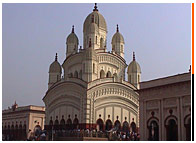 India
has probably the world’s richest heritage of spirituality.
It’s not just the birthplace and centre of Hinduism, which
dates back 5000 odd years, and of other major religions such as
Buddhism, Jainism and Sikhism but also a major centre for Christians,
Muslims and Zorastrians among others. India
has probably the world’s richest heritage of spirituality.
It’s not just the birthplace and centre of Hinduism, which
dates back 5000 odd years, and of other major religions such as
Buddhism, Jainism and Sikhism but also a major centre for Christians,
Muslims and Zorastrians among others.
One of the oldest living religions in the world, Hinduism is unique
among the world religions in that it had no single founder but grew
over a period of 4,000 years with the religious and cultural movements
of the Indian subcontinent. The term religion is very loosely applied,
as it is more a collection of attitudes and social organization,
of forms of worship and popular beliefs than a formal set of tenets.
The religion itself is a synthesis of the religions brought into
India by the Aryans (c.1500 B.C.) and indigenous faiths and rituals.
Hinduism is an ocean of beliefs and
modes of worship that comprise the most sublime philosophies and
intricate ritualism. The deities worshipped are numerous and diverse
– besides the vast and complex Hindu pantheon they include
objects of nature and natural phenomena. This is because of Hinduism’s
defining tenet of Oneness, or God not as a separate entity but a
manifestation of everything around.
As diverse in nature as the deities, are the temples that venerate
and celebrate them. From the great temple towns of Madurai and Kancheepuram
and the cave temples of Badami in Southern India, from the erotic
temple sculpture in Khajuraho in Central India to the monolithic
stone chariot in the Sun temple of Konarak in Eastern India, from
the filigreed marble edifices of the Jain temples in Western India
to the humble ashram-retreats of rishis (renunciates) on the banks
of the Ganges and the pilgrim’s path to the holy Mt Kailash
in the Himalayas, there is a wealth of antiquity and architectural
diversity to be discovered in every region of the country.
|



